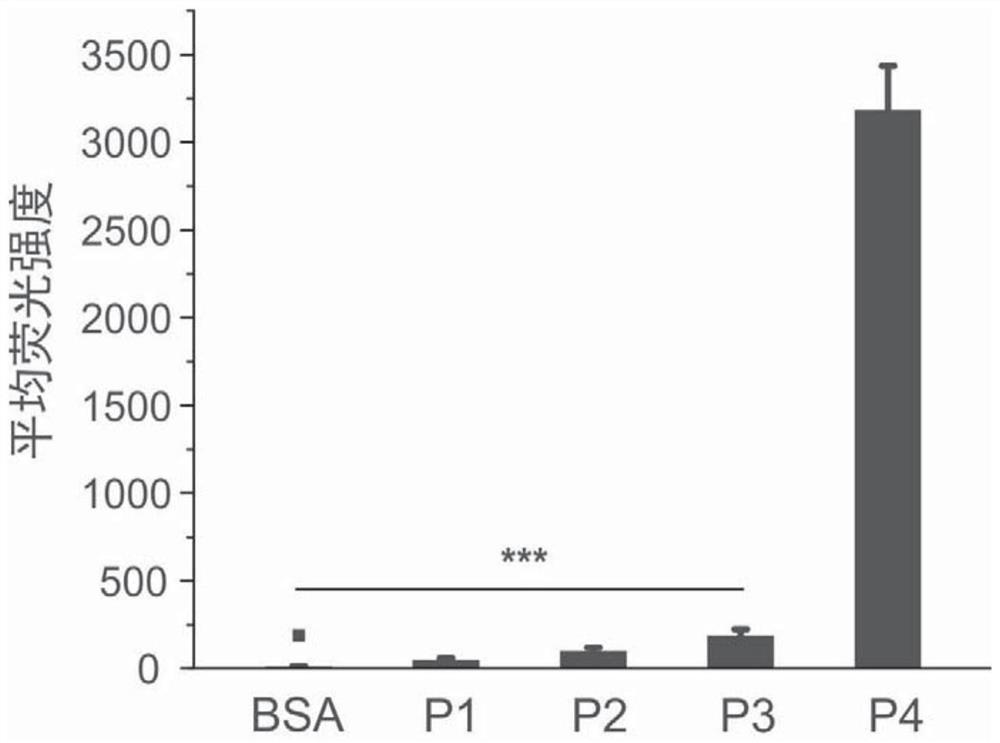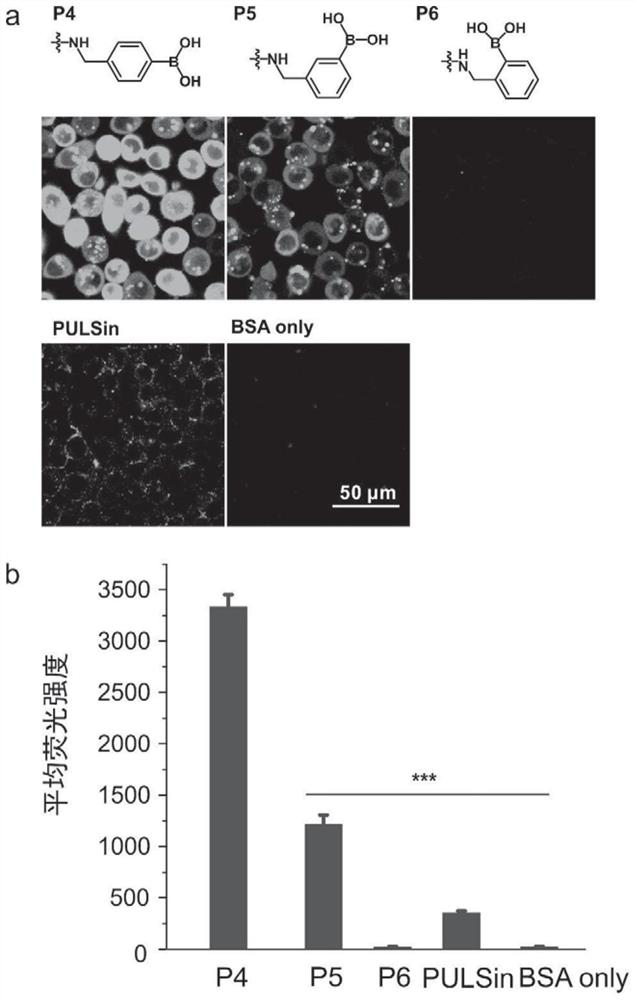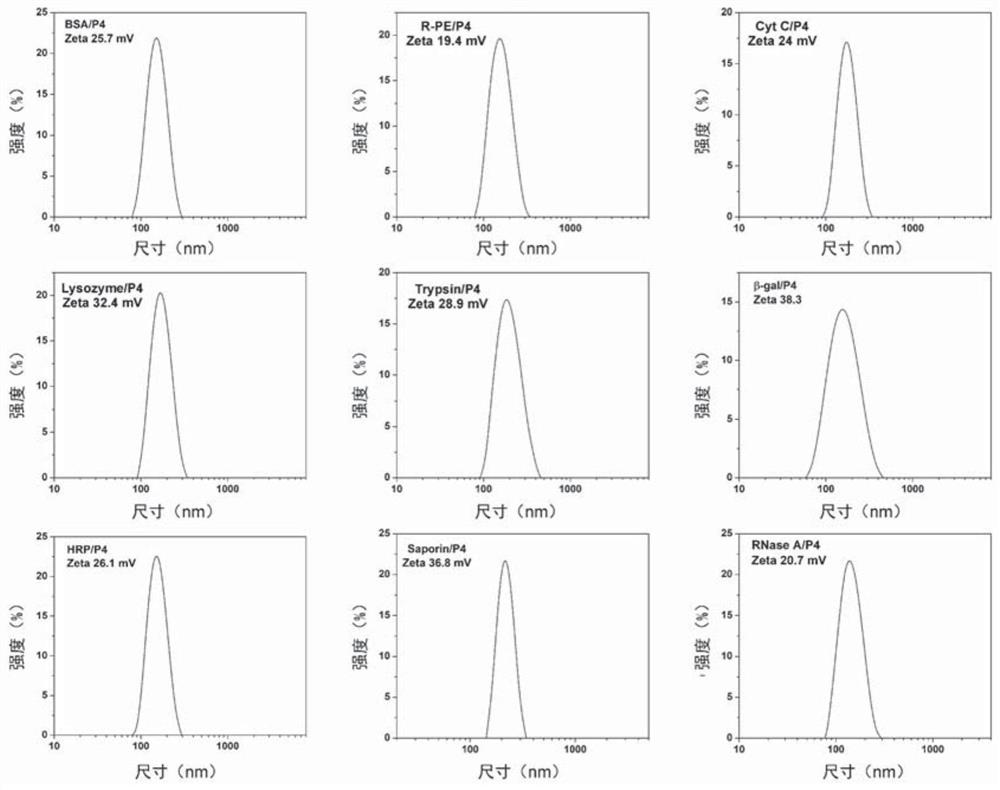Phenylboronic acid-containing modified polymer material and application thereof in intracellular delivery of proteins and polypeptides
A polymer material, a technology containing phenylboronic acid, applied in the intracellular delivery of proteins and small peptides, in the field of polymer materials, can solve the problem that polymer carriers cannot bind proteins and peptides well
- Summary
- Abstract
- Description
- Claims
- Application Information
AI Technical Summary
Problems solved by technology
Method used
Image
Examples
Embodiment 1
[0053] Example 1: Synthesis of protein and polypeptide intracellular delivery carriers P1-P6 based on polyamide-amine dendrimers and functional groups containing phenylboronic acid.
[0054] In a specific embodiment, the preparation method of the polymer material modified with phenylboronic acid is as follows: 4-bromomethylphenylboronic acid and the fifth generation polyamidoamine dendrimer are mixed according to different molar ratios (26: 1, 38:1, 96:1, 128:1) were added into the methanol solution, heated and reacted at 70°C for 24 hours, transferred to the dialysis bag, fully dialyzed in methanol and deionized water respectively, separated and purified to obtain the product, respectively Four kinds of phenylboronic acid-modified dendrimers (as shown in formula (9)) with different grafting ratios. according to 1 H NMR nuclear magnetic spectrum characterizes the connection efficiency of phenylboronic acid on the surface of polyamide-amine dendrimer, and calculates the averag...
Embodiment 2
[0062] Example 2: Comparison of protein intracellular delivery efficiency of dendrimers P1-P4 modified with phenylboronic acid
[0063] Using green fluorescein FITC-labeled bovine serum albumin (BSA-FITC) as a model protein, the delivery efficiency of phenylboronic acid-modified dendrimer was evaluated on HeLa cells by detecting intracellular fluorescence, and the optimal material was screened.
[0064] The specific method is as follows: inoculate HeLa cells into 48-well plates overnight, and start the protein delivery experiment when the density of HeLa cells reaches above 80%. After BSA-FITC was thoroughly mixed with P1, P2, P3 and P4 prepared in Example 1 of the present invention, 100 μL of serum-free medium was added, and vortexed to mix. After incubating at room temperature for 30 minutes, 150 μL of serum-free medium was added to the mixed solution. Remove the cell medium, wash twice with PBS, add the medium solution containing the protein complex, and incubate for 4 hou...
Embodiment 3
[0066] Example 3: Comparison of protein intracellular delivery efficiency of dendrimer materials P4-P6 modified with phenylboronic acid
[0067] Using green fluorescein FITC-labeled bovine serum albumin (BSA-FITC) as a model protein, the delivery efficiency of boronic acid compound-modified dendrimer was evaluated on HeLa cells by detecting intracellular fluorescence, and the optimal material was screened.
[0068] The specific method is as follows: inoculate HeLa cells into 48-well plates overnight, and start the protein delivery experiment when the density of HeLa cells reaches above 80%. After fully mixing BSA-FITC with P4, P5, and P6 respectively, add 100 μL of serum-free medium, shake and mix well. After incubating at room temperature for 30 minutes, 150 μL of serum-free medium was added to the mixed solution. Remove the cell medium, wash twice with PBS, add the medium solution containing the protein complex, and incubate for 4 hours in a 37°C incubator. Afterwards, the...
PUM
| Property | Measurement | Unit |
|---|---|---|
| Size | aaaaa | aaaaa |
Abstract
Description
Claims
Application Information
 Login to View More
Login to View More - R&D
- Intellectual Property
- Life Sciences
- Materials
- Tech Scout
- Unparalleled Data Quality
- Higher Quality Content
- 60% Fewer Hallucinations
Browse by: Latest US Patents, China's latest patents, Technical Efficacy Thesaurus, Application Domain, Technology Topic, Popular Technical Reports.
© 2025 PatSnap. All rights reserved.Legal|Privacy policy|Modern Slavery Act Transparency Statement|Sitemap|About US| Contact US: help@patsnap.com



